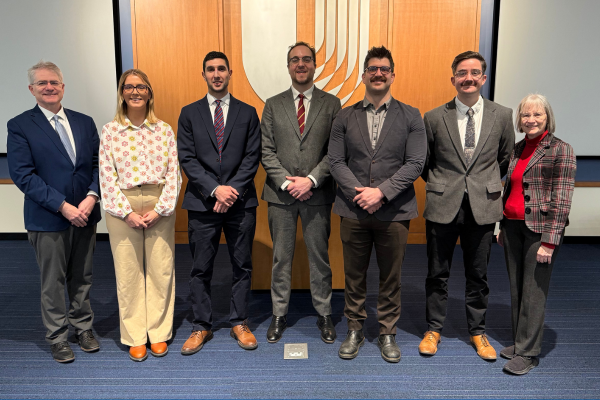
The 2025 Bone and Joint Research Society (BJR) Traveling Fellows presented their groundbreaking research at Duke Orthopaedics' Grand Rounds on February 19. This distinguished event spotlighted the latest advancements in orthopaedic science, showcasing the innovative contributions of leading British researchers. The fellows, representing prestigious institutions across the UK, shared their cutting-edge approaches to tackling complex bone and joint challenges. Their visit was expertly organized and hosted by Dr. Virginia Byers Krauss, MD, PhD, professor of Medicine, Pathology, and Orthopaedic Surgery, a Duke Molecular Physiology Institute member, and an affiliate of the Regeneration Next Initiative.
Timothy Hopkins, MD
Versus Arthritis Foundation Fellow, Queen Mary University of London – Organ-on-a-Chip Modeling of Human MSK Tissues
Dr. Hopkins discussed innovative solutions in arthritis research, explicitly targeting the mechanisms behind joint degeneration. His work examines molecular and cellular responses in the joints, seeking to unravel new strategies for halting or even reversing damage caused by arthritis. His promising findings in disease-modifying treatments could significantly improve patient outcomes in the long term.
Ryan Jones, PhD
Postdoctoral Researcher, Cardiff University – Invitro Modeling of the Bone Noninceptor Interface in Osteoarthritis
Dr. Jones presented on biomechanical engineering and its applications in orthopaedics. His research includes the development of advanced wearable technologies designed to monitor joint movement and mechanical load. These tools are expected to enhance the personalized treatment of musculoskeletal conditions, providing real-time data that could guide clinical decisions and rehabilitation protocols.
Harriet Talbot, PhD
Lecturer in Medical Engineering, University of Hull – Can We Improve Biomechanics and Reduce Lower Limb Bleed Risk in PwH Through Functional Footwear?
Dr. Talbot's presentation focused on medical engineering techniques to advance joint replacement technologies. Her research explores explicitly the development of customized, 3D-printed implants that could improve the fit and longevity of joint replacements. By leveraging advanced engineering, her work aims to minimize complications and enhance the success of orthopaedic surgeries.
Tim Lindsay, MD, PhD
Academic Clinical Fellow, Imperial College London – Arthroplasty as a Life-Saving Intervention
Dr. Lindsay shared his interdisciplinary research, combining orthopaedic surgery with molecular biology. His work investigates genetic and epigenetic factors influencing bone repair and regeneration, aiming to improve surgical outcomes in patients undergoing joint replacements. He also discussed potential future therapies that could harness these biological pathways to accelerate recovery.
Muhamed Farhan-Alanie, MD
NIHR Doctoral Research Fellow, University of Warwick – The Effects of Computer Navigation and Patient-Specific Instrumentation on Risk of Revision, Patient-Reported Outcome Measures, and Mortality Following Primary TKR – Analysis of National Joint Registry Data
Dr. Farhan-Alanie focused his remarks on the intersection of regenerative medicine and orthopaedics. His research investigates novel biomaterials and stem cell therapies to promote healing and regeneration in musculoskeletal tissues. His talk emphasized how these cutting-edge therapies could transform treatment options for joint diseases and injuries.
The Grand Rounds session provided a rich platform for the BJR Traveling Fellows to demonstrate the significant strides British orthopaedic research is making. Their work promises to deliver exciting advancements in treatment strategies for musculoskeletal conditions, offering hope for better outcomes and innovative therapies in the future.